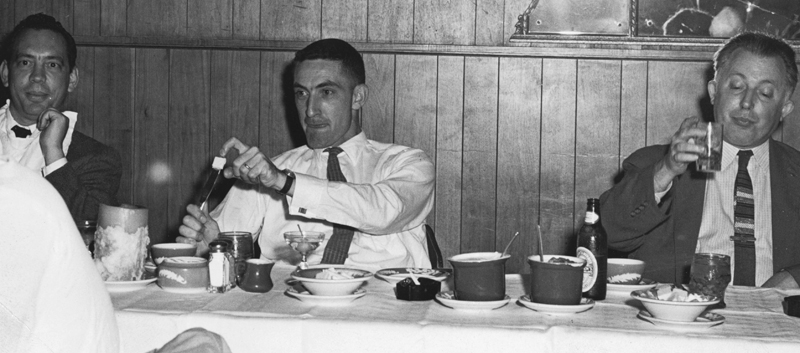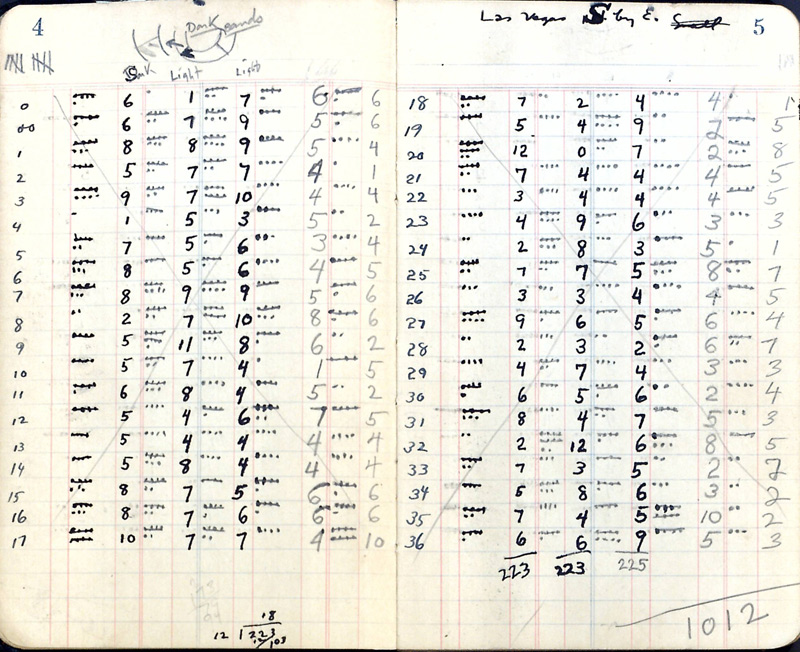The Huntington’s blog takes you behind the scenes for a scholarly view of the collections.
EXHIBITIONS | Beyond the Numbers
Posted on Wed., Oct. 19, 2011 by and
The Aerospace History Project at The Huntington Library has taken off. Since 2007, the burgeoning archive documenting the history of the aerospace industry in Southern California has continued to grow. Just two weeks ago, a new exhibition—"Blue Sky Metropolis: The Aerospace Century in Southern California"—opened to highlight about 50 photos, documents, and artifacts from The Huntington's holdings.
There is what you would expect to find in aerospace collections, such as blueprints and business correspondence documenting the daily work of engineers and scientists, but there are also unexpected items that subvert the stereotypical image—such as a photo of JPL engineer Albert R. Hibbs flipping butter at a banquet table. But for every item on display, there are thousands of others that remain in the archive awaiting review by scholars, including a collection of notebooks that document a successful "system" for beating the odds on roulette in Reno and Las Vegas.
Hibbs was the architect of the early space exploration programs at the Jet Propulsion Laboratory and known as the "Voice of JPL" for his descriptions of early satellite programs on television and radio. During a break from graduate school in 1948, he and a friend headed to Reno in an attempt to earn enough money to buy a boat and sail around the world. Hibbs, a physicist and mathematician, realized that any product made by humans, including roulette wheels, had to have imperfections. For hundreds of hours he recorded the winning numbers on numerous wheels in notebooks to determine which wheels did indeed have a statistical bias. The bias occurred when tiny grooves appeared on the wheel after much use. At the first casino he turned a $50 investment into $6,500, after which the management replaced the roulette wheel. Unfortunately we're not able to take advantage of Hibbs' scheme because the gambling industry quickly took note of his profits and made it procedure to replace wheels daily.
In addition to the Hibbs collection, The Huntington's holdings also include the personal papers of Ben Rich, the head of Lockheed's covert Skunk Works and designer on the SR-71 Blackbird and the F-117 Stealth aircraft; Willis Hawkins, aerospace engineer and first head of Lockheed Missiles and Space; Harvey Christen, one of Lockheed's earliest employees; and Jack Real, Lockheed engineer and close confidant of Howard Hughes.
Recent donations have included the personal papers of Clarence "Kelly" Johnson, founder of the Lockheed Skunk Works; George Kruska, involved in the construction of the Spruce Goose; and Roy Anderson, President of the Lockheed Corporation in the late 1970s and early 1980s.
The Aerospace History Project has also recently benefitted from its first corporate contributions, arriving from the archives of Northrop Grumman, manufacturer of military aircraft, defense electronics, and precision weapons; and Crane Aerospace and Electronics' Hydro-aire materials, which document the first anti-skid brake control systems for modern planes.
The Aerospace History Project is an initiative of the Huntington-USC Institute on California and the West. The exhibition "Blue Sky Metropolis" is on view through Jan. 9, 2012.
Brook Engebretson and Emily Wittenberg are aerospace project archivists at The Huntington.

